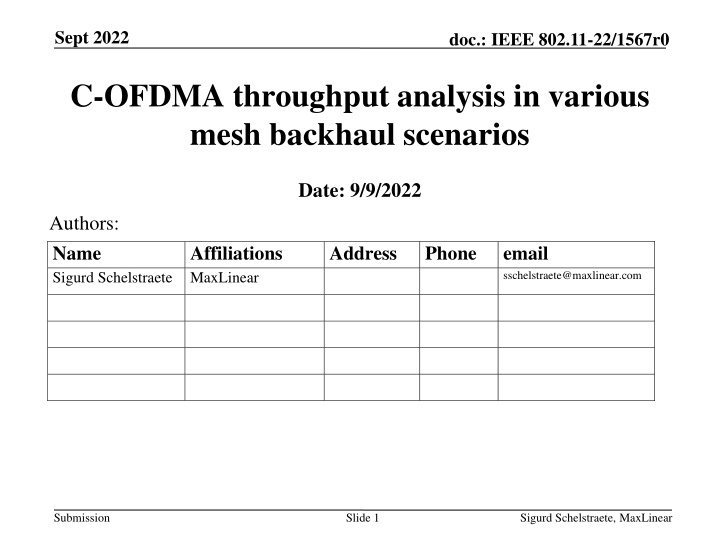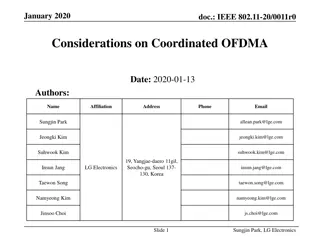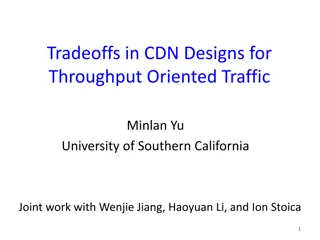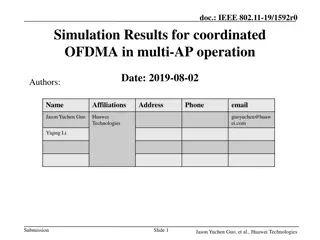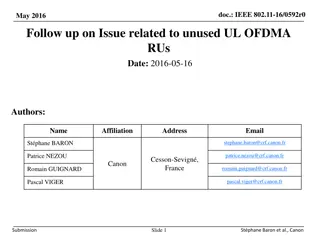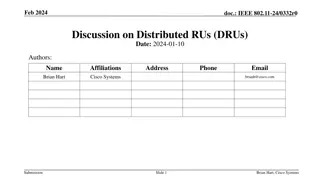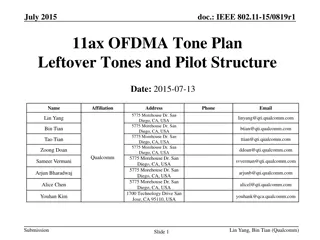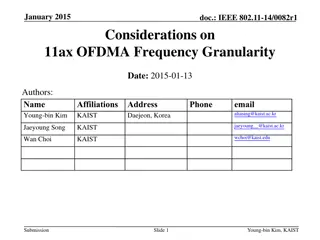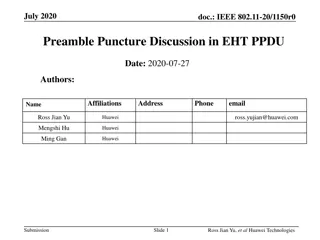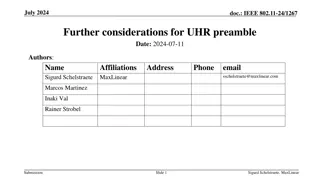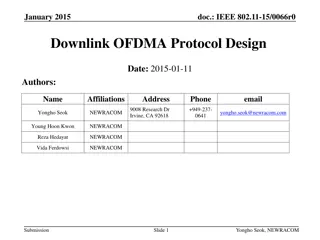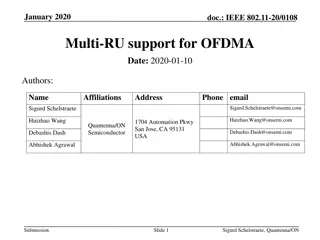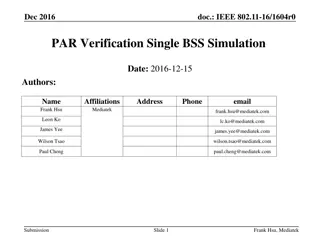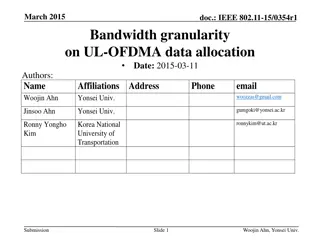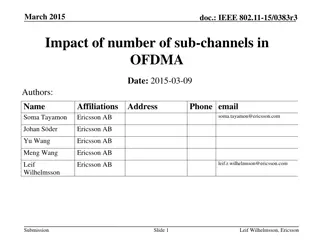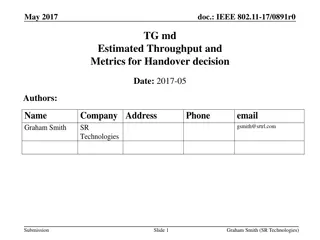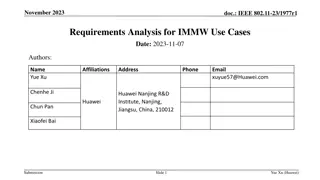IEEE 802.11-22 C-OFDMA Throughput Analysis
This document explores the potential enhancement in throughput by incorporating C-OFDMA into mesh backhaul scenarios in residential deployments. It evaluates the benefits and improvements in network performance through multi-AP coordination and resource allocation.
Download Presentation

Please find below an Image/Link to download the presentation.
The content on the website is provided AS IS for your information and personal use only. It may not be sold, licensed, or shared on other websites without obtaining consent from the author.If you encounter any issues during the download, it is possible that the publisher has removed the file from their server.
You are allowed to download the files provided on this website for personal or commercial use, subject to the condition that they are used lawfully. All files are the property of their respective owners.
The content on the website is provided AS IS for your information and personal use only. It may not be sold, licensed, or shared on other websites without obtaining consent from the author.
E N D
Presentation Transcript
Sept 2022 doc.: IEEE 802.11-22/1567r0 C-OFDMA throughput analysis in various mesh backhaul scenarios Date: 9/9/2022 Authors: Name Sigurd Schelstraete MaxLinear Affiliations Address Phone email sschelstraete@maxlinear.com Submission Slide 1 Sigurd Schelstraete, MaxLinear
Sept 2022 doc.: IEEE 802.11-22/1567r0 Abstract We consider C-OFDMA added to (in-home) mesh network We consider several backhaul scenarios We evaluate possible throughput enhancement Submission 2 Sigurd Schelstraete, MaxLinear
Sept 2022 doc.: IEEE 802.11-22/1567r0 Introduction Many residential deployments already use mesh topology One Main AP connected to internet Secondary AP(s) serve subset of STAs and forward traffic from the main AP Goal of mesh topology is to extend range of data delivery We consider addition of C-OFDMA to this scenario as a possible incremental improvement to overall throughput natural evolution of mesh deployments SR, nulling, more appropriate for OBSS scenarios instead We evaluate aggregate throughput of C-OFDMA vs. SU-only transmissions Submission 3 Sigurd Schelstraete, MaxLinear
Sept 2022 doc.: IEEE 802.11-22/1567r0 Definitions C-OFDMA Form of Multi-AP coordination One AP ( Sharing AP ) initiates channel access and inquires about requested resources from other APs ( Shared APs ) Based on feedbacks from Shared APs, the Sharing AP allocates final resources among all participating APs Allocations are in the frequency domain All participating APs send concurrently occupying their allocated resources Backhaul Traffic from Sharing AP to Shared APs intended for connected STA(s) Fronthaul Traffic between an AP and its connected STA(s) Submission 4 Sigurd Schelstraete, MaxLinear
Sept 2022 doc.: IEEE 802.11-22/1567r0 Why evaluate C-OFDMA throughput improvement? OFDMA is not typically associated with throughput improvements in high-traffic scenarios Resources are shared between multiple users, no new resources created Only when MAC overhead dominates data (e.g., preponderance of short packets), some performance benefit is seen Latency improvements may be of more interest C-OFDMA has some inherent benefits relative to OFDMA that make throughput evaluation worthwhile: Airtime benefit: Less contention/collisions compared to SU with hops Single AP effectively controls all network access Power benefit: Several APs can transmit simultaneously at full power Higher MCS possible when using part of the band (i.e. when doing OFDMA) Submission 5 Sigurd Schelstraete, MaxLinear
Sept 2022 doc.: IEEE 802.11-22/1567r0 Simulation Scenarios Single AP serves whole network Two remote devices Mesh topology - SU only Two secondary mesh APs SU for backhaul and AP-STA links All transmissions on the same channel Mesh topology with C-OFDMA Higher MCS due to power gain SU for Backhaul Whenever possible, C-OFDMA for fronthaul links AP1 initiates C-OFDMA All transmissions on the same channel Submission 6 Sigurd Schelstraete, MaxLinear
Sept 2022 doc.: IEEE 802.11-22/1567r0 Evaluation Methodology Target: Maximize aggregate network throughput Which configuration provides highest aggregate throughput? As measured between traffic endpoints, i.e., excluding any backhaul traffic Typical Methodology: Full buffer scenario: pump high data rate to each of the STAs Excess packets are dropped from Tx buffer Aggregate performance determined by network conditions This methodology does not work for C-OFDMA Excess packets are delivered over the backhaul from the Sharing AP to the Shared APs and are only dropped from the Tx buffer of the Sharing AP Airtime is spent transmitting backhaul packets that will not be sent from Sharing AP to its STA This creates Backhaul inefficiency Submission 7 Sigurd Schelstraete, MaxLinear
Sept 2022 doc.: IEEE 802.11-22/1567r0 Backhaul inefficiency in C-OFDMA illustrated SU operation independent of traffic rates Backhaul delivers amount of traffic that matches AP-STA link capacity Backhaul delivers more traffic than can be handled by the Sharing AP-STA link. Wasted airtime reduces overall network performance. Non-full buffer scenario: all traffic delivered. No throughput difference between SU and C- OFDMA Backhaul airtime usage maxes out. Further increases in data rate do not cause further reduction in airtime availability. Submission 8 Sigurd Schelstraete, MaxLinear
Sept 2022 doc.: IEEE 802.11-22/1567r0 Backhaul inefficiency in C-OFDMA Happens when Fronthaul and Backhaul share the same channel Allows for simpler devices Will evaluate alternative scenarios later Hard to match backhaul transmissions to AP-STA link capacities without inefficiency Either backhaul too high, leading to backhaul transmission of packets that will ultimately be dropped at the Sharing AP Or backhaul traffic may be too low to fully utilize capacity of the Shared AP-STA link Not just a testing/simulation issue: If Shared AP-STA link is oversubscribed, it will impact overall network capacity because of excess airtime used by the backhaul excess = backhaul delivers more data than final link can support Submission 9 Sigurd Schelstraete, MaxLinear
Sept 2022 doc.: IEEE 802.11-22/1567r0 Simulation assumptions To avoid the backhaul inefficiency in C-OFDMA, traffic rates for C- OFDMA scenario are gradually increased to find the optimum Backhaul runs independently: no synchronization with C-OFDMA, always uses SU Padding in C-OFDMA frames is minimized Basic C-OFDMA protocol elements are accounted for Submission 10 Sigurd Schelstraete, MaxLinear
Sept 2022 doc.: IEEE 802.11-22/1567r0 Simulation Results (3 AP scenario) Minor performance improvement from C-OFDMA Requires fine tuning of backhaul C-OFDMA gains from: Collision avoidance Higher MCS C-OFDMA overhead: Additional protocol Possible backhaul inefficiency Submission 11 Sigurd Schelstraete, MaxLinear
Sept 2022 doc.: IEEE 802.11-22/1567r0 Alternative backhaul scenarios Key issue in previous simulations is the Wireless Backhaul sharing the same medium as fronthaul data, which leads to inefficiencies Alternatives include: Off-channel wireless backhaul hides the backhaul inefficiency issue Increase in needed wireless resources Wired backhaul Especially in in-home deployment scenarios, a wired alternative may be available Does not impact wireless spectrum availability Packet forwarding can be done at higher layers Submission 12 Sigurd Schelstraete, MaxLinear
Sept 2022 doc.: IEEE 802.11-22/1567r0 Simulation Results (3 AP scenario) Throughput significantly higher for both SU and C- OFDMA In-channel Wireless backhaul represents significant part of overall airtime consumption Inefficiency avoided Or rather, hidden off-channel Some gain between SU and C- OFDMA Submission 13 Sigurd Schelstraete, MaxLinear
Sept 2022 doc.: IEEE 802.11-22/1567r0 Conclusions We have evaluated possible performance improvement of C- OFDMA over SU in an in-home scenario Use of wireless backhaul in C-OFDMA on the same channel leads to several inefficiencies Less airtime available to data Inefficiency in matching backhaul to actual data requirement when using C- OFDMA Wired backhaul or off-channel wireless backhaul eliminates both types of inefficiency in-channel Extra resources are used off-channel Backhaul inefficiency (backhaul/fronthaul mismatch) may still exist off- channel Submission 14 Sigurd Schelstraete, MaxLinear
Sept 2022 doc.: IEEE 802.11-22/1567r0 Conclusions C-OFMDA does provide some (minor) throughput gain over SU-only Most gain from moving the backhaul off-channel Latency remains to be evaluated Backhaul and fronthaul need to be matched to avoid resource inefficiency Multi-AP specification should be compatible with both wireless and wired backhaul scenarios Coordinated operation can accommodate this easily Joint operation may require explicit format definition Submission 15 Sigurd Schelstraete, MaxLinear
Sept 2022 doc.: IEEE 802.11-22/1567r0 Back-up slides Submission Slide 16 Sigurd Schelstraete, MaxLinear
Sept 2022 doc.: IEEE 802.11-22/1567r0 Airtime Usage Multi-AP with C-OFDMA (optimal backhaul) Airtime Usage Multi-AP without C-OFDMA Submission 17 Sigurd Schelstraete, MaxLinear
Sept 2022 doc.: IEEE 802.11-22/1567r0 Backhaul Backhaul Airtime Usage Multi-AP with C-OFDMA (inefficient backhaul) Airtime Usage Multi-AP with C-OFDMA (optimal backhaul) Submission 18 Sigurd Schelstraete, MaxLinear
